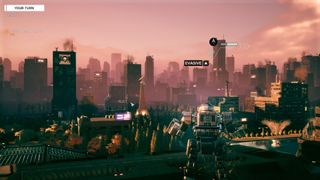
Don’t get me wrong—I love taking a Jenner for a leisurely jog through the mountains or laying down a blanket of LRMs to glass the shimmering sands of a haunting, lonely desert. But that’s never been the natural environment for mech battles, as far as I’m concerned. The iconic BattleTech experience is punching your enemies right through the front window of a seafood restaurant, demolishing some high-rise apartments with stray laser beams, and having your lightweights dart in and out of a dense office park to take sneaky pot-shots. Urban Warfare delivers on that experience, among other things. And it feels good.
The metropolitan environments in Urban Warfare are well-designed and present novel tactical challenges. The maps are a good mix of terrain types, with crowded streets and skyscrapers broken up by open plazas and city parks that make sure you have some options if street-to-street brawling and gunslinging isn’t your style. This creates some niches for lance compositions that aren’t especially viable in BattleTech’s other environs. I found the widespread availability of cover and sight blockers to be a boon to lighter mechs, especially. Using their speed to set up very narrow firing lines and then darting back into safety can be very powerful, especially with accurate, long-ranged weaponry.
And if you’ve got jump jets, even more new possibilities open up since you can jet up to the roof of most buildings to rain death from on high. I found this to be a very powerful scouting ability as well, allowing me to take up a position on a well-placed tower and spot for my indirect fire mechs without putting any of my MechWarriors in too much danger. This tactic does present its own risks, however, since just about everything is destructible. Missed shots now hit objects behind your intended target, and you can target buildings directly. A scout mech that takes a fall from 30 stories because an enemy Colossus decided he wasn’t a fan of that particular city block is going to be a bit worse for wear, and totally exposed as a result. The same is true if an enemy is using the urban sprawl for cover. With enough firepower, you can literally level the playing field with just a bit of high explosive and elbow grease.
Beyond creating new tactical opportunities, it just looks and feels right. Games and movies about giant robots hit a sweet spot when their well-oiled stars are racking up millions in collateral damage, crushing minivans underfoot, and giving insurance companies heart attacks. It’s such a joyous and resonant experience that the expansion could have easily been called BattleTech: Homecoming.
The other major expansion feature is electronic warfare, which comes in two varieties. Electronic Countermeasures can jam long-ranged targeting, which is a great way to shut down opponents who like to strap LRMs onto as many hard points as possible and shower the battlefield with ruin, occasionally hitting an actual mission target. So it’s there to specifically counter my playstyle, basically. Lucky for us indirect fire fans, the accompanying 1.6 patch adds the Catapult C4 as a consolation prize—a variant that dares to ask, “What if missiles, but too many?”
On the offensive end of electronic warfare, you can now deploy Active Probes, which remotely provide data on a targeted area of the battlefield without having to risk the life of that new guy who got stuck with the Locust until he can prove he’s responsible enough for a real mech. These can be very powerful, especially on urban maps where sight blockers are plentiful. Since I like to run with heavier, slower mechs most of the time, it’s really nice to have an alternate option for scouting.

BattleTech definitely feels like a more complete and varied game with the addition of urban maps. And there’s no denying that laying waste to the urban environments with giant, stompy death machines is one of life’s simple pleasures.
PC Gamer Newsletter
Sign up to get the best content of the week, and great gaming deals, as picked by the editors.
Most Popular


